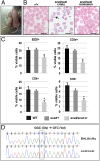Critical function for the Ras-GTPase activating protein RASA3 in vertebrate erythropoiesis and megakaryopoiesis
- PMID: 22773809
- PMCID: PMC3409772
- DOI: 10.1073/pnas.1204948109
Critical function for the Ras-GTPase activating protein RASA3 in vertebrate erythropoiesis and megakaryopoiesis
Abstract
Phenotype-driven approaches to gene discovery using inbred mice have been instrumental in identifying genetic determinants of inherited blood dyscrasias. The recessive mutant scat (severe combined anemia and thrombocytopenia) alternates between crisis and remission episodes, indicating an aberrant regulatory feedback mechanism common to erythrocyte and platelet formation. Here, we identify a missense mutation (G125V) in the scat Rasa3 gene, encoding a Ras GTPase activating protein (RasGAP), and elucidate the mechanism producing crisis episodes. The mutation causes mislocalization of RASA3 to the cytosol in scat red cells where it is inactive, leading to increased GTP-bound Ras. Erythropoiesis is severely blocked in scat crisis mice, and ~94% succumb during the second crisis (~30 d of age) from catastrophic hematopoietic failure in the spleen and bone marrow. Megakaryopoiesis is also defective during crisis. Notably, the scat phenotype is recapitulated in zebrafish when rasa3 is silenced. These results highlight a critical, conserved, and nonredundant role for RASA3 in vertebrate hematopoiesis.
Conflict of interest statement
The authors declare no conflict of interest.
Figures






References
-
- Mikkola HK, Orkin SH. Gene targeting and transgenic strategies for the analysis of hematopoietic development in the mouse. Methods Mol Med. 2005;105:3–22. - PubMed
-
- Orkin SH. Transcription factors and hematopoietic development. J Biol Chem. 1995;270:4955–4958. - PubMed
-
- Orkin SH, Zon LI. Genetics of erythropoiesis: Induced mutations in mice and zebrafish. Annu Rev Genet. 1997;31:33–60. - PubMed
-
- Peters LL, McFarland-Starr EC, Wood BG, Barker JE. Heritable severe combined anemia and thrombocytopenia in the mouse: Description of the disease and successful therapy. Blood. 1990;76:745–754. - PubMed
Publication types
MeSH terms
Substances
Grants and funding
LinkOut - more resources
Full Text Sources
Molecular Biology Databases

